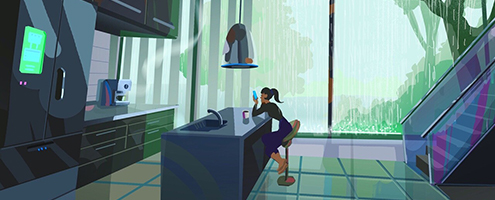INTERVIEW
with Lera Nyukalova
by Jessica Fernandes, Spark CG Society
February 20, 2020
I first had the pleasure of meeting Lera Nyukalova at a Diversity and Inclusion Summit breakfast at SPARK FX 2019. We happened to sit next to one another, sensed a friendly creative vibe, and quickly got to chatting. Turns out she was the artist behind the beautiful SPARK FX branding and illustration I had been seeing all weekend! Our conversation drifted from art, to life in Vancouver and how she was settling into the industry here. When I heard she was creating the artwork for SPARK 2020, I knew it would be impressive. Below is a sneak peak, and insights into the talented woman behind the artwork.

What first got your started in the arts? Can you tell us a bit about your background?
I've always been interested in art and I've been drawing and painting ever since I can remember. But it was only around grade 5 that I sensed I had a stronger handle on how to draw 3D objects, living creatures, and shapes better than my classmates. I'm from Kazakhstan, so after grade 9, I attended an architecture college in my town (Almaty) to study design. The school structure there is different than in North America. My course load included disciplines like graphic design, architecture, interior design, and industrial design. I enjoyed all these classes... up to the point when I had to be precise. I enjoyed the creative aspects of the classes, but when it came to doing the math and counting millimeters with my ruler I was getting extremely bored and making mistakes. I was really into digital painting by that point in my life, and seeing how much I enjoyed the creative side of things, I realized I wanted to be a concept artist.

My college didn't have classes for 3D, so I went to the only 3D school that was available at that time in my city and took an interior design course. The teacher was great and allowed me to do a sci-fi space station for my final project. I ended up dropping out of school after my 4th year to work as an illustrator in a small advertising and graphic design agency. The company was very young and ambitious. They guided me and allowed me to grow as an artist by giving me full creative freedom and room to explore. I was doing everything from ginormous digital paintings for print, to storyboards for different ads, comic books, postcards, patterns for brands, and illustrations for different products. What I most appreciate is that they allowed me to make mistakes and learn from them, which helped me grow. I'm forever grateful for that experience.
What brought you to Vancouver?
I wanted to get a better education. Unfortunately, at home we don't have any schools that can teach digital media because that industry doesn't exist there. At first, I thought about going to Europe but not many schools had courses in English. The U.S. was out of my price range and Canada seemed like a nice place to live. I went to an international university recruitment event in my city and took an interest in Capilano University. What first struck me was their booklet cover. It featured an illustration by one of their IDEA students, something I hadn't seen any other university do. It piqued my interest, so I checked out their program and was happy to discover that it included both graphic design and illustration: exactly what I was doing at my full-time job! I wasn't sure if I could make it in Canada in any other profession, so I went for it.
Have you noticed a difference in the art scene or view on art between the places you've lived? Has this influenced or impacted your art?
Of course. We didn't have an art scene in my hometown. I had never heard of art exhibitions or festivals happening — even less about digital art. My only exposure to this had been on the internet. Since moving to Canada, I've had much more exposure to art in general and in person. As a result, my art has started to have more purpose. Before, I would paint just to paint. Now I try to tell a story and I learn new ways of doing so every day.
How has your art style changed/evolved over the years?

My style changed when I moved here. In my early digital paintings, I tried to render every detail to make sure it was visible in the final piece. After moving, my style became simpler because I had limited time to paint. My first year in Vancouver, I was studying English and adjusting to living in a new country. And when I got into university I was also working part-time as a concept artist in a mobile game studio, so I was working and studying every day for the next two years. I had to do my homework and keep up with my job, so I developed a simpler style in order to work faster without compromising quality. Along the way I also had teachers and work colleagues guiding me, which really helped me develop a good work structure and style.
You're obviously a skilled digital artist, but as evident in your IG feed, you've also done lovely work in ink, drawing, and watercolours. Do you have a preference between traditional and digital mediums?
Thanks! I love traditional art and I'm hoping to return to it at some point. I try to do Inktober once a year but beyond that, right now I can't find an excuse to paint traditionally since my job is in the digital realm. Sometimes I feel like I'm going crazy staring at the screen for so long every day — I hope one day all devices will have an electronic ink screen, like a Kindle reader. My eyes badly need it!
You've worked in a number of different areas, including VR, mobile, and animation. Do they differ much from a concept standpoint? Are there different considerations to take into account?
I would say they're similar and different at the same time. They all involve the same painting skills but the thinking behind them is quite different. It's all about considering how the user/viewer interacts in each medium. In Animation it's about storytelling. In VR it's about the player's experience and comprehension of the environment — like designing a theatre experience. Mobile games is about making bright, appealing, high quality art that draws attention and keeps the player coming back for more.


I see a lot of people, characters, and creatures featured in your personal work and sketches. Are those areas you would ideally like to specialize in? Or are you just as happy working on hard surface design and environments?
To be honest, in both my personal and professional work, I prefer the world-building of environment design more than straight-up character design. Most of the characters I've created are to support a story I want to tell (I rarely paint them strictly to design a character). They always reflect my feelings, taste or something I'm curious about. With environment design, however, it's about creating worlds. Here I get to create a habitat for different characters and their story — thinking about how they live, what they like, what their everyday tasks are, what their lifestyles are like. I can tell the story of their past, and maybe even their future, their relationships, etc. I find it really exciting. The more I do it, the more I love it.

Is there a project that holds a special place in your heart? If so, why?
Not really. As long as I get creative freedom and I'm having fun, I'm happy to work on anything.
Is there a dream project you'd like to work on?
I would love to work on an animated feature one day. That's something I haven't done yet and would like to explore.
What are you currently working on?
Currently, I'm a designer on Last Kids on Earth, at Atomic Cartoons. We have an incredibly strong and talented team. I've made lots of friends and I'm super proud to be part of this show.
What's your creative process?

I'm guessing my process isn't that different than that of other artists. It's a lot of research at the beginning, then thinking about what I want to show and how I can best do so. I look at a bunch of Pinterest reference, create a reference Photoshop file, make thumbnails to get the composition right, then do the line work, block in colours, add lighting, and finally, nitpick and noodle. It may sound easy, but some stages can take hours and hours.
Where do you find your inspiration?
When I'm lazy, scrolling through Pinterest and checking out other artists' work. When I'm not lazy, tapping into my own experiences.
What have been your greatest challenge?
I guess, balancing work and life... which is likely everyone's greatest challenge nowadays. I've been trying to pay more attention to living in the now, instead of thinking about my job 100% of the time. I exercise more now, eat well, and get good sleep. However, I still can't find enough time to work on personal projects, get through the piles of books that I've bought to read, and I don't have as much quiet time as I would like to. But at the same time, I want to be good at what I do and have an impact on the projects I'm assigned to. That's the challenge, balancing both.
What would you like people to take from your art?
I hope people get connected to the pieces I create — that's what I'm trying to achieve every time I make something new. My hope is that people will experience or get a sense for the emotions and experiences that inspired me to paint an image, when viewing it.

Thank you so much to Lera for taking the time to chat with us! We're so happy to have you on the SPARK team, and we look forward to seeing more of your beautiful work. Here's to your continued success in all that you do!

 |
Jessica Fernandes is an adventurer and wordsmith based in Vancouver. She enjoys spreading appreciation for the arts through stories and encounters with inspiring creators. |
![]()
![]()
© 2025 · Spark CG Society
















